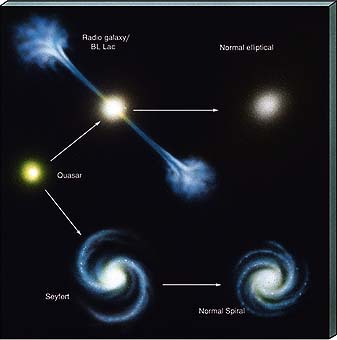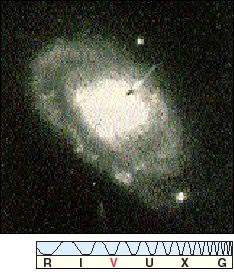In Chapters 23 and 24 we addressed the issue of evolutionary change in normal galaxies.
(Secs. 23.4, 24.4) Let us now briefly consider the possibility of evolutionary links among active galaxies and between normal and active galaxies. We emphasize that this section is really mostly speculation. Although the consensus is that galaxies began to form some 9—10 billion years ago (corresponding to a redshift of 5, the upper limit on the measured redshifts of known quasars—see Table 25.1) and that quasars were an early stage of galaxy evolution, the details of the connections among different types of active and normal galaxies remain uncertain.
Most quasars are very distant, indicating that they were more common in the past than they are today. At the same time, normal-looking galaxies seem to be less common in the distant past. These two pieces of evidence suggest to many astronomers that when galaxies first formed, they probably were quasars. This opinion is strengthened by the fact that the same black-hole energy-generation mechanism can account for the luminosity of quasars, active galaxies, and the central regions of normal galaxies like our own. Large black holes do not simply vanish, at least in the 10—20 billion years that the universe has existed (see More Precisely 22-3). Thus, the presence of supermassive black holes in the centers of many, if not all, normal galaxies is consistent with the idea that they started off as quasars, then "wound down" to become the relatively quiescent objects we see today.
In this picture, the gradual reduction in violence from a quasar to a Seyfert galaxy to a normal spiral, for example, occurs primarily because the fuel supply is reduced as the galaxy evolves. A similar sequence might connect quasars to BL Lac objects (Interlude 25-1) to radio galaxies to normal ellipticals. These possible evolutionary connections among the active and normal galaxies are illustrated in Figure 25.25. Adjacent objects along this sequence are nearly indistinguishable from one another. For example, weak quasars share some characteristics with some very active galaxies, and the feeblest active galaxies often resemble the most explosive normal galaxies.

Figure 25.25 A possible evolutionary sequence for galaxies, beginning with the highly luminous quasars, decreasing in violence through the radio and Seyfert galaxies, and ending with normal spirals and ellipticals. The central black holes that powered the early activity are still there at later times; they simply run out of fuel as time goes on.
If we accept this appealing (but still unproven) view, we can construct the following possible scenario for the evolution of galaxies in the universe. Galaxies began to form about 10 billion years ago. The early round of massive star formation that may have expelled galactic gas and possibly helped determine a galaxy's Hubble type—spiral or elliptical—could also have given rise to many large, stellar-mass black holes, which sank to the center of the still-forming galaxy and merged into a supermassive black hole there. Alternatively, the supermassive hole may have formed directly by gravitational collapse of the dense central regions of the protogalaxy. Whatever the cause, large black holes appeared at the centers of many galaxies at a time when there was still plenty of fuel available to power them, resulting in many highly luminous quasars. The brightest quasars—the ones we see from Earth—were those with the greatest fuel supply.
Young galaxies at this early stage were much fainter than their bright quasar cores. As a result, until very recently, astronomers were hard-pressed to discern any galactic structure in quasar images. Although computer-enhanced, ground-based observations hinted at wispy "fuzz" in some quasar images, evidence for host galaxies surrounding quasars was inconclusive. In 1996 several groups of astronomers used the Hubble Space Telescope to take up the challenge. Early results were ambiguous, but after removing the bright quasar cores from the Hubble images and carefully reanalyzing the remnant light, researchers have reported that in every case studied—a total of about a dozen quasars so far—there appears to be a normal host galaxy enveloping the quasar. Figure 25.26 shows one of the longest exposures ever taken of a quasar. Even without sophisticated computer processing, the host can clearly be seen. Indeed, there is even some resemblance to a normal spiral galaxy, with thin arms extending away from the core.

Figure 25.26 This long-exposure Hubble image of a distant quasar clearly shows the young host galaxy in which the quasar resides, lending strong support to the view that quasars represent an early, very luminous phase of galaxy evolution. The quasar has the catalog name PG0052+251 and resides roughly 500 Mpc from Earth.
As the galaxy developed and the black hole used up its fuel the luminosity of the central nucleus diminished. Although still active, the quasar no longer completely overwhelmed the emission from the surrounding stars. The result was an active galaxy—a radio galaxy or a Seyfert—still emitting a lot of energy but now with a definite "stellar" component in its spectrum.
The central activity continued to decline. Eventually, only the surrounding galaxy remained visible—a normal galaxy, like the majority of those we now see around us. Today the black holes that generated so much youthful energy lie dormant in galactic cores, producing only a relative trickle of radiation. Occasionally, two nearby normal galaxies may interact with each other, causing a flood of new fuel to be directed toward the central black hole of one or both. The engine starts up for a while, giving rise to the nearby active galaxies we observe.
Should this picture be correct—and the confirmation of host galaxies surrounding many quasars lends strong support to this view—then many normal galaxies, including perhaps our own Milky Way Galaxy, were once brilliant quasars. Perhaps some alien astronomer, thousands of megaparsecs away, is at this very moment observing our Galaxy—seeing it as it was billions of years ago—and is commenting on its enormous luminosity, nonstellar spectrum and high-speed jets, and wondering what exotic physical process can possibly account for its violent activity!
When they were first discovered, active galaxies and quasars seemed to present astronomers with insurmountable problems. For a time their dual properties of enormous energy output and small size appeared incompatible with the known laws of physics and threatened to overturn our modern view of the universe. Yet the problems were eventually solved, and the laws of physics remain intact. Far from jeopardizing our knowledge of the cosmos, these violent phenomena have become part of the thread of understanding that binds our own Galaxy to the earliest epochs of the universe in which we live.